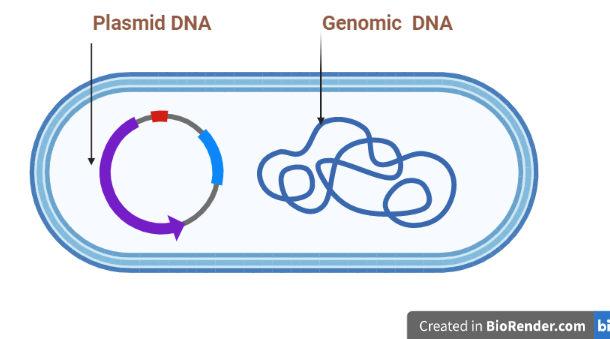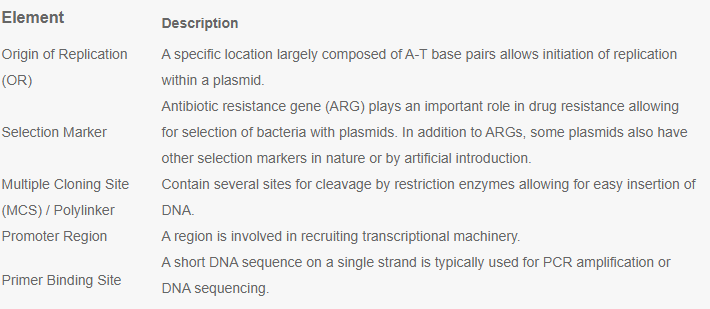Introduction:
A plasmid is a small, circular pieces of double-stranded DNA molecule that is distinct from a cell’s chromosomal DNA. Occasionally, linear plasmids that are made of RNA also exist. Joshua Lederberg introduced the term “plasmid” in 1952. They are mostly present in bacteria, but they can also be found in archaea and eukaryotes like yeast and plants.

Fig: Plasmid DNA
Properties:
- Plasmids are self-replicating genetic components made up of covalently closed, circular, double-stranded DNA.
- Their sizes range from a few kilobase pairs to several hundred.
- They are available in three forms: supercoiled (closed circle), nicked (open circle), and linear. Although most bacteria are supercoiled, certain species are linear.
- Both gram-positive and gram-negative bacteria contain them.
- They have minimal to no similarity with the host chromosomal DNA sequences.
Structure:

Fig: Structure of plasmid
The three most important characteristics of plasmid vectors are as follows:
Origin of replication
This origin allows the plasmid’s replicon, a section of around 1000 bp encoding the location at which DNA replication begins, to efficiently replicate the plasmid to a high number of copies of cells.
Presence of selectable marker
Most plasmid vectors contain a gene that imparts antibiotic resistance to microorganisms. This enables for the selection of plasmid-carrying clones in antibiotic-containing media.
Cloning, or restriction enzyme, cleavage site
All cloning vectors must have at least one cloning site (a specific DNA sequence identified and cut by a restriction endonuclease) into which foreign DNA can be introduced.

Fig: Description on the structure of plasmid
Types:
Fertility plasmids–F plasmids (conjugation)
Resistance plasmids–R plasmids (antibiotic resistance)
Col plasmids–encode colicins (bacteroicins)
Virulence plasmids–encode determinants required for pathogenesis
Metabolic plasmids-mediate degradation of toxic compounds
Function:
- They encode a variety of phenotypic characteristics that are not required for the host organisms but provide them with features that allow them to adapt to different settings, such as antibiotic resistance or unique chemical metabolism. Plasmids that have inherent functionality encode for replication and stability.
- Plasmids may determine a wide range of functions besides antibiotic resistance, including virulence and metabolic capacities.
- The primary role of plasmids is to transport antibiotic-resistant genes throughout the human or animal body. Many human and animal diseases can be treated this way.
- Another role of plasmids is to contain genes engaged in metabolic activities that aid in the digestion of contaminants in the environment.
- They can also make antimicrobial proteins.
- Plasmids can also carry genes involved in boosting the pathogenicity of bacteria that cause diseases such as anthrax and tetanus.
Plasmid DNA and recombinant DNA technology:
Plasmid DNA generated artificially is an important component in the synthesis of genetically modified plant species, medicinal medicines, and proteins. Plasmids are used for a variety of reasons in recombinant DNA technology. This method uses plasmids to implant the desired medicine into the body. They also contribute to antibiotic resistance and are used to eliminate dangerous germs in the body. For the first time, recombinant DNA technology was used on the human body to install human insulin. It produced excellent outcomes. Plasmids are also used to implant human growth hormone into mammalian cells of animals.
Protocol for extraction of plasmid and purification:
The plasmid purification process, often known as miniprep, is a popular method for isolating and purifying plasmid DNA from bacterial cultures. The technique begins with spinning of the bacterial cells, followed by resuspension in lysis buffer to liberate the plasmid DNA. To stabilize the DNA, the lysate is next treated with a neutralizing buffer. Cell debris and chromosomal DNA are separated from the cleaned lysate supernatant using centrifugation. The supernatant is treated with ethanol to precipitate the plasmid DNA, which is subsequently bound to a miniprep spin column selectively. Following the removal of impurities, the pure plasmid DNA is eluted from the column with an elution buffer. This eluted DNA can be used for cloning, sequencing, or transfection, among other applications.

Fig: Plasmid Purification (Miniprep) Protocol
References:
- Schmidt, T., Friehs, K. and Flaschel, E., 2001. Structures of plasmid DNA. Plasmids for therapy and vaccination, pp.29-43.
- Shintani M, Sanchez ZK, Kimbara K. Genomics of microbial plasmids: classification and identification based on replication and transfer systems and host taxonomy. Front Microbiol. 2015 Mar 31;6:242. doi: 10.3389/fmicb.2015.00242. PMID: 25873913; PMCID: PMC4379921.
- Yagi, Y.R.J.D.F.D., Kessler, R.E., Shaw, J.H., Lopatin, D.E., An, F. and Clewell, D.B., 1983. Plasmid content of Streptococcus faecalis strain 39-5 and identification of a pheromone (cPD1)-induced surface antigen. Microbiology, 129(4), pp.1207-1215.
- David P. Clark, Nanette J. Pazdernik, Michelle R. McGehee, Chapter 23 – Plasmids, Editor(s): Molecular Biology (Third Edition), Academic Cell, 2019, Pages 712-748,
